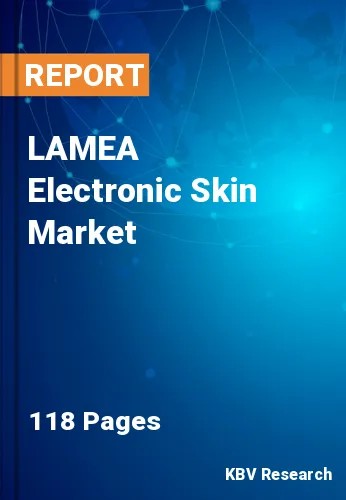The Latin America, Middle East and Africa Electronic Skin Market would witness market growth of 25.5% CAGR during the forecast period (2023-2030).
Gallium nitride, renowned for its piezoelectric properties—the ability to generate an electrical signal in reaction to mechanical strain and mechanical vibration in response to an electrical impulse—is the material at the sensor's center. It is an ultrathin, high-quality film that is used in the sensor. Gallium nitride is a two-way piezoelectric material that can be used for both wireless communication and sensing, according to the study's findings.
Interest in the areas of drug distribution, health monitoring, and therapeutic purposes has increased with the development of 3D printing as well as artificial intelligence. Electronic skin is becoming more widely accepted for various medical conditions, including diabetes, the cardiovascular system, pregnancy, and anomaly detection. Numerous ongoing studies are devoted to understanding these technologies, particularly when used in tandem.
In addition, various forms of artificial smart e-skins are urgently needed in the rapidly developing sectors of clinical medicine, health monitoring, and prosthetics. Future e-skins will intelligently react to variations in their surroundings based on the novel transmission of information technology, which has an exciting prospect for developing e-skins. This is similar to genuine human skin that can adapt and provide real-time feedback based on various external stimuli through the peripheral nervous system.
According to the World Bank, the Caribbean has the highest rates of non-communicable disease morbidity and mortality in the larger Latin America and Caribbean (LAC) region, with diabetes, cardiovascular disease, and cancer continuously ranking among the top 5 causes of death. The developed e-skin has a sensor that can recognize handwriting printed on it and detect things 20 cm away. It can also react to stimuli in a fraction of a tenth of a second. One of its greatest applications is expected to be health monitoring. Thus, all of these elements will aid in developing the regional market in the coming years.
The Brazil market dominated the LAMEA Electronic Skin Market by Country in 2022 and would continue to be a dominant market till 2030; thereby, achieving a market value of $346.9 million by 2030. The Argentina market is anticipated to grow at a CAGR of 26.2% during (2023 - 2030). Additionally, The UAE market would exhibit a CAGR of 25.2% during (2023 - 2030).
Based on Sensors, the market is segmented into Electrophysiological Sensors, Tactile Sensors, Chemical Sensors, and Others. Based on Component, the market is segmented into Stretchable Circuits, Stretchable Conductors, Photovoltaic Systems, and Electroactive Polymers. Based on Application, the market is segmented into Health Monitoring Systems, Drug Delivery Systems, and Cosmetics. Based on Product, the market is segmented into Electronic Skin Suits, and Electronic Patches. Based on countries, the market is segmented into Brazil, Argentina, UAE, Saudi Arabia, South Africa, Nigeria, and Rest of LAMEA.
Free Valuable Insights: The Worldwide Electronic Skin Market is Projected to reach USD 22.3 Billion by 2030, at a CAGR of 22.9%
The market research report covers the analysis of key stake holders of the market. Key companies profiled in the report include Medidata Solutions, Inc. (Dassault Systems SE), Xsensio S.A., Xenoma Inc., VivaLNK, Inc., iRhythm Technologies, Inc., Renesas Electronics Corporation, QUAD Belgium nv/sa, Koninklijke Philips N.V., and ROTEX.
By Sensors
By Component
By Application
By Product
By Country
Our team of dedicated experts can provide you with attractive expansion opportunities for your business.

